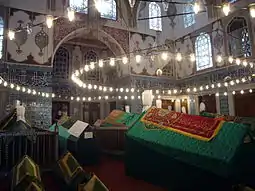Mihrişah Kadın
Mihrişah Kadın (Turkish: Emine Mihrişah Kadın; Ottoman Turkish: امینه مھرشاہ قادین meaning "Light of the King"; in Persian died; April 1732)[4] was a consort of Sultan Ahmed III and the mother of Sultan Mustafa III.[5]
| Mihrişah Kadın | |||||
|---|---|---|---|---|---|
 The burial place of Mihrişah Kadın is located inside The Cedid Havatin outbuilding the mausoleum of Turhan Sultan, next to the tomb of her fellow consort Şermi Kadın,[1] in New Mosque at Eminönü in Istanbul. | |||||
| Died | April 1732[2] Eski Palace, Beyazıt Square, Constantinople, Ottoman Empire (modern-day Istanbul, Turkey) | ||||
| Burial | Imperial ladies Mausoleum, New Mosque, Eminönü, Istanbul | ||||
| Spouse | Ahmed III | ||||
| Issue |
| ||||
| |||||
| Religion | Sunni Islam | ||||
Life
After entering the imperial harem she was given the name Mihrişah (meaning "Light of the King" in Persian).
On 25 August 1710 she gave birth to her first son Şehzade Süleyman (died 11 December 1732), on 28 January 1717 she gave birth to her second son Şehzade Mustafa. [6] In 1728, she gave birth to her third son Şehzade Seyfeddin, [3] and the same year when Süleyman was eighteen and Mustafa was eleven she commissioned two fountains in Üsküdar.[7][8]
Ahmed was deposed in 1730, and his nephew Sultan Mahmud I ascended the throne. Mihrişah along with other ladies of Ahmed's harem went to the Eski Palace, at Beyazıt Square.
Death and aftermath
She died in 1732 ,and was buried in the mausoleum of Imperial Ladies, New Mosque, Istanbul.[9]
Şehzade Mustafa ascended the throne as Mustafa III after Sultan Osman III's death in 1757. However, she was never Valide Sultan, as she had died before Mustafa ascended the throne. He commissioned the Ayazma Mosque in memory of his mother, and elder brother Şehzade Süleyman.[10][11] A fountain is also present near her tomb.[9]
Issue
Together with Ahmed, Mihrişah had three children:
- Şehzade Suleiman (25 August 1710 - 11 December 1732, buried in New Mosque, Istanbul)
- Sultan Mustafa III (Edirne Palace, Edirne, 28 January 1717 - Istanbul, Turkey, 21 January 1774, buried in Laleli Mosque, Fatih, Istanbul), married five times and had nine children;
- Şehzade Seyfeddin (3 February 1728[12] – 1732, buried in New Mosque, Istanbul); [3]
See also
References
- Sakaoğlu 2008, p. 303.
- Sakaoğlu 2008, p. 302.
- Haskan 2001, p. 1167.
- Haskan 2001, p. 1118.
- Sakaoğlu 2008, p. 417.
- Uluçay 1985, p. 81.
- Fountain of Şehzade Mustafa
- Fountain of Şehzade Süleyman
- Ayvansaray-i 2000, p. 23.
- Uluçay 1980, p. 82.
- Uluçay 1985, p. 82.
- Aktaş 2008, p. 255-6.
Sources
- Aktaş, Ali (2008). ÇELEBİZÂDE ÂSIM TARİHİ: Transkripsiyonlu metin.
- Ayvansaray-i, Hafiz Hueseyin (2000). The Garden of the Mosques: Hafiz Hüseyin Al-Ayvansarayî's Guide to the Muslim Monuments of Ottoman Istanbul. Brill. ISBN 978-9-004-11242-1.
- Haskan, Mehmed Nermi (2001). Yüzyıllar Boyunca Üsküdar, Volume 3. Üsküdar Belediyesi. ISBN 978-9-759-76063-2.
- Sakaoğlu, Necdet (2008). Bü mülkün kadın sultanları: Vâlide sultanlar, hâtunlar, hasekiler, kadınefendiler, sultanefendiler. Oğlak Yayıncılık. ISBN 978-9-753-29623-6.
- Uluçay, Mustafa Çağatay (1985). Padışahların kadıları ve kızları. Türk Tarih Kurumu Basımevi.
- Uluçay, Mustafa Çağatay (1980). Türk Tarih Kurumu yayınları. Türk Tarih Kurumu.
.svg.png.webp)